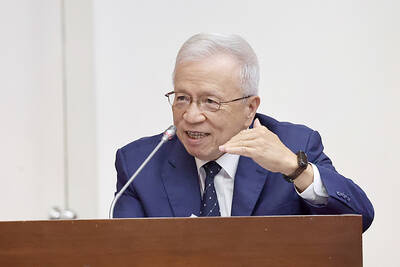Private think tank Polaris Research Institute (寶華綜合經濟研究院) yesterday revised downward its GDP growth forecast for this year to 2.5 percent, from the 3.88 percent it estimated in March, as worse-than-expected exports in the first half of the year raised pessimism regarding economic sentiment over next half year.
Polaris is the latest domestic think tank to cut Taiwan’s GDP growth forecast for this year to less than 3 percent.
Earlier this month, the Taiwan Research Institute (台灣綜合研究院) slashed its GDP growth forecast for this year to 2.52 percent, from the 4.02 percent it estimated in December last year, while Cathay Financial Holding Co’s (國泰金控) research team revised its GDP growth forecast for this year to 2.45 percent, from the 3.73 percent it estimated in March.
The Directorate-General of Budget, Accounting and Statistics (DGBAS), which last month forecast the economy would expand 3.03 percent this year, is scheduled to update its growth forecast on July 31.
“The economic indicators did not show good signals in the first half of the year, further raising our pessimism for the full-year economy,” Polaris president Liang Kuo-yuan (梁國源) told a press conference.
Worse-than-expected export figures in the second quarter have led the institute to revise downward its economic growth forecast for the April-to-June period to 0.4 percent, from the 3.16 percent it estimated in March.
Exports dropped 5 percent from a year earlier in the first five months, data from the Ministry of Finance showed.
Meanwhile, continued uncertainties in the global economy were the other major factor leading the institute to cut its full-year GDP growth forecast, Liang said.
The institute forecast that economic growth in the third and fourth quarter would reach 3.35 percent and 5.6 percent respectively on the back of a base effect and a recovering economy in China, which may help drive up demand for Taiwanese products.
However, Liang said both the global economy and Taiwan’s economy were facing “anemic growth,” which indicates growing momentum will maintain sluggish for longer than initially estimated.
In this situation, the global economy will be easily dragged down by external shocks, which may further affect export-oriented countries like Taiwan, he said.
However, Liang said the central bank could keep its currency policy more flexible to drive up short-term export momentum, providing some strength for the nation’s economy.
On the inflation front, Polaris raised its growth forecast on the consumer price index (CPI) this year to 1.9 percent, from 1.57 percent.
The institute expects inflationary pressure to reach a peak in the third quarter this year, with annual CPI growth reaching 2.66 percent.

JITTERS: Nexperia has a 20 percent market share for chips powering simpler features such as window controls, and changing supply chains could take years European carmakers are looking into ways to scratch components made with parts from China, spooked by deepening geopolitical spats playing out through chipmaker Nexperia BV and Beijing’s export controls on rare earths. To protect operations from trade ructions, several automakers are pushing major suppliers to find permanent alternatives to Chinese semiconductors, people familiar with the matter said. The industry is considering broader changes to its supply chain to adapt to shifting geopolitics, Europe’s main suppliers lobby CLEPA head Matthias Zink said. “We had some indications already — questions like: ‘How can you supply me without this dependency on China?’” Zink, who also

At least US$50 million for the freedom of an Emirati sheikh: That is the king’s ransom paid two weeks ago to militants linked to al-Qaeda who are pushing to topple the Malian government and impose Islamic law. Alongside a crippling fuel blockade, the Group for the Support of Islam and Muslims (JNIM) has made kidnapping wealthy foreigners for a ransom a pillar of its strategy of “economic jihad.” Its goal: Oust the junta, which has struggled to contain Mali’s decade-long insurgency since taking power following back-to-back coups in 2020 and 2021, by scaring away investors and paralyzing the west African country’s economy.

BUST FEARS: While a KMT legislator asked if an AI bubble could affect Taiwan, the DGBAS minister said the sector appears on track to continue growing The local property market has cooled down moderately following a series of credit control measures designed to contain speculation, the central bank said yesterday, while remaining tight-lipped about potential rule relaxations. Lawmakers in a meeting of the legislature’s Finance Committee voiced concerns to central bank officials that the credit control measures have adversely affected the government’s tax income and small and medium-sized property developers, with limited positive effects. Housing prices have been climbing since 2016, even when the central bank imposed its first set of control measures in 2020, Chinese Nationalist Party (KMT) Legislator Lo Ting-wei (羅廷瑋) said. “Since the second half of

Taiwan Semiconductor Manufacturing Co (TSMC, 台積電) received about NT$147 billion (US$4.71 billion) in subsidies from the US, Japanese, German and Chinese governments over the past two years for its global expansion. Financial data compiled by the world’s largest contract chipmaker showed the company secured NT$4.77 billion in subsidies from the governments in the third quarter, bringing the total for the first three quarters of the year to about NT$71.9 billion. Along with the NT$75.16 billion in financial aid TSMC received last year, the chipmaker obtained NT$147 billion in subsidies in almost two years, the data showed. The subsidies received by its subsidiaries —